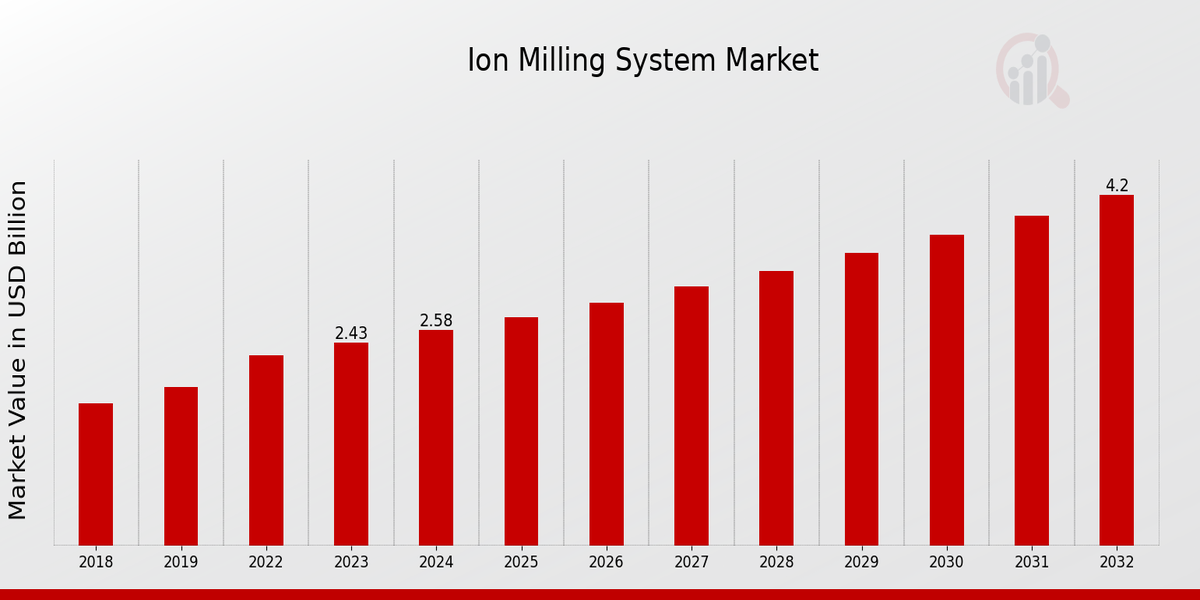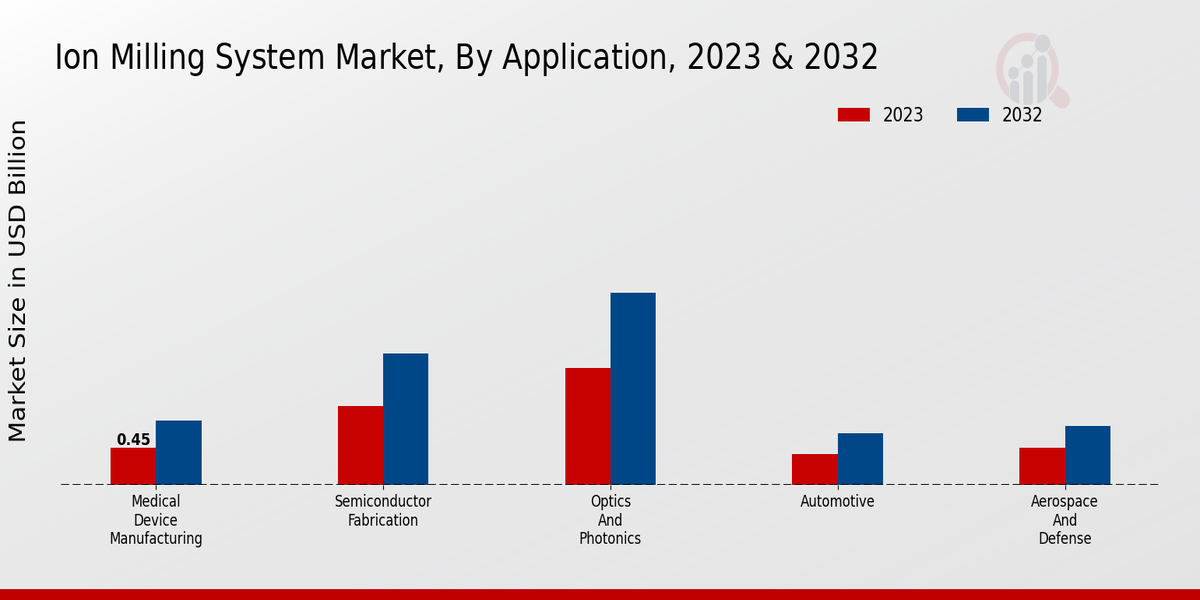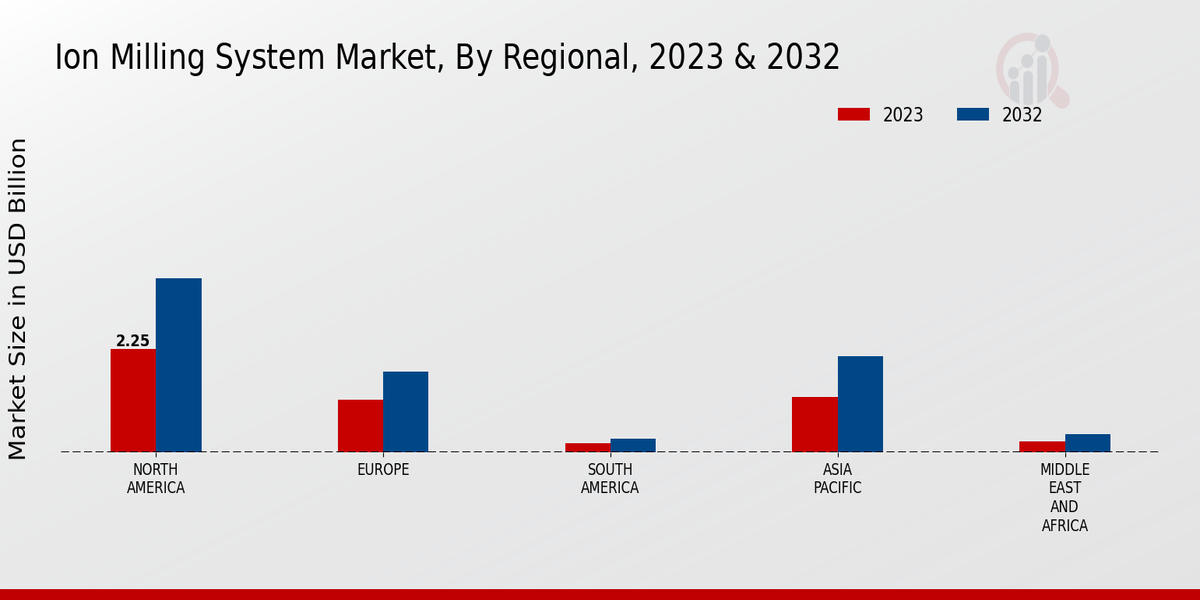Global Ion Milling System Market Overview
The Ion Milling System Market Size was estimated at 2.74 (USD Billion) in 2024. The Ion Milling System Industry is expected to grow from 2.91(USD Billion) in 2025 to 5.04(USD Billion) by 2034. The Ion Milling System Market CAGR (growth rate) is expected to be around 6.3% during the forecast period (2025 - 2034).
Key Ion Milling System Market Trends Highlighted
The market for ion milling systems is confirmed to witness excellent growth on account of increased demand from end-user segments such as semiconductor fabrication, biomedical and microelectronics. With that, deep penetration in electronic devices and their miniaturization, in addition to the aspects of vigorous surface modification, pushes growth.
Market forces affecting the industry include the increasing need for ion beam etching and deposition techniques, which assist in the fabrication of more advanced semiconductors. In addition, the increasing interest in ion milling in application fields such as in the manufacture of medical devices and tissue engineering is envisaged to assist in calculating the growth of the market.
New trends in ion milling systems include the creation of high-resolution targeting ion beams, micro ion optics, and cutting-edge process control systems. Such improvements lead to decreased completion times and enhanced precision and material removal rates. Also, the ability to incorporate ion milling systems with other nanofabrication methods creates room for exploring new applications and materials. There is an increasing trend towards fabricating specialized ion milling systems adapting to specific customer sectors which will enable the market to grow further.

Source: Primary Research, Secondary Research, MRFR Database and Analyst Review
Ion Milling System Market Drivers
-
Growing Demand for Advanced Semiconductor Devices
The international ion milling system market is positively influenced by the increasing requirement for refined semiconductor devices. Of particular significance is the ion milling process as it is applicable in etching the required patterns into the surfaces of the wafers in the manufacturing of such devices. The increase in demand for advanced semiconductor devices can be attributed to the growing penetration of smartphones, tablets, and other electronics. This factor is anticipated to remain a plus to the ion milling system market. Due to the increasing enhancement in semiconductor devices, other factors responsible for the growth of the ion milling system market are added.
As devices are becoming increasingly complex, the demand for using more delicate and accurate as well as controlled etching is becoming higher. On the other side, ion milling systems offer the advantage of high accuracy and control in etching, which makes them applicable in the market of current semiconductor devices. The introduction of 3D NAND technology is also one of the factors that will determine the growth of the ion milling system market. This particular technology is based on the utilization of three-dimensional structures operating a storage medium and is useful in the manufacturing of flash memory.
More detailed and controlled etching is necessary in this type of structure than in the two-dimensional NAND structure. As a result, the requirements of the newer technology may contribute to the demand for ion milling systems. To summarize, it can be said that the emerging need for more sophisticated semiconductor devices and the increasing complexity of such devices, together with the advent of 3D NAND technology, are likely to foster further expansion of the ion milling system market.
Increasing Adoption of Microelectromechanical Systems (MEMS)
The increasing adoption of microelectromechanical systems (MEMS) is another key driver of the ion milling system market. MEMS are small devices that combine electrical and mechanical components on a single chip. They are used in a wide range of applications, including automotive, medical, and consumer electronics. Ion milling is used to etch patterns into the surface of MEMS devices. This process is critical for the performance of MEMS devices, as it determines the electrical and mechanical properties of the device.The growing adoption of MEMS devices is expected to continue to drive the demand for ion milling systems. In addition, the increasing demand for miniaturized and portable devices is also driving the adoption of MEMS devices. MEMS devices are smaller and more portable than traditional mechanical devices, making them ideal for use in small and portable devices. The growing demand for miniaturized and portable devices is expected to further drive the adoption of MEMS devices, which in turn is expected to benefit the ion milling system market. Overall, the increasing adoption of MEMS devices, the growing demand for miniaturized and portable devices, and the critical role of ion milling in the fabrication of MEMS devices are expected to continue to drive the growth of the ion milling system market.
Government Initiatives and Funding
Government initiatives and funding are also playing a role in the growth of the ion milling system market. Governments around the world are investing in research and development of advanced semiconductor technologies, including ion milling. This investment is expected to continue to drive the development of new and innovative ion milling systems. In addition, governments are also providing funding for the purchase of ion milling systems by research institutions and companies.This funding is expected to help to increase the adoption of ion milling systems, which in turn is expected to benefit the ion milling system market. Overall, government initiatives and funding are expected to continue to play a key role in the growth of the ion milling system market.
Ion Milling System Market Segment Insights
Ion Milling System Market Application Insights
The prominent end-use industries in the Application segment of the Ion Milling System Market are highly diverse and facilitate the growth of the market in several ways. One of the major applications in the Medical Device Manufacturing industry is the increasing demand for precision machining of medical implants, surgical instruments, and dental prosthetics. Another key industrial concern in the Application segment is Semiconductor Fabrication, primarily due to the importance of ion milling systems in the patterning and etching of semiconductor wafers.Optics and Photonics are also becoming significant applications, as the ion milling system is necessary for high-precision surface finishing of optical components and fiber optics. Moreover, the use of ion milling systems in the Automotive industry is primarily intended for surface preparation, coating removal, and micromachining of automotive parts. The Aerospace and Defense applications are significant because aircraft and defense systems are highly reliant on lightweight and durable materials.

Source: Primary Research, Secondary Research, MRFR Database and Analyst Review
Ion Milling System Market Type Insights
The Ion Milling System Market is segmented into the following types such as planar ion millers, focused ion beam systems, and dual beam systems. Planar ion millers are the most frequently applied type of ion milling system. These devices are used for a wide variety of applications, such as sample preparation for microscopy, thin film deposition, and device fabrication. Planar ion millers are also generally the least expensive and easiest to operate, making them a good solution for many applications. Focused ion beam systems are applied for more precise applications, such as circuit editing and repair.These systems use a focused beam of ions to mill away material with high precision. FIB systems are generally much more expensive than planar ion millers but also provide much more precision and control. Lastly, there are dual beam ion millers which are also more versatile as they can perform both planar ion beam milling and more precise applications using a focused ion beam. These devices are the most expensive overall. For the year 2023, the planar ion millers’ segment is expected to account for the largest share of the Ion Milling System Market revenue.The FIB systems segment is expected to grow at the highest CAGR during the forecast period. The growth of the said segment is due to the continually increasing demand for high-precision ion milling applications in the semiconductor and electronics industries.
Ion Milling System Market Beam Type Insights
The Ion Milling System Market is segmented by Beam Type into Argon Ion Beam, Xenon Ion Beam, Helium Ion Beam, Nitrogen Ion Beam, and Oxygen Ion Beam. Among these, the Argon Ion Beam segment held the largest market share in 2023, accounting for over 50% of the Ion Milling System Market revenue. The Argon Ion Beam segment is expected to continue its dominance throughout the forecast period, owing to its high efficiency and precision in various applications. The Xenon Ion Beam segment is projected to witness the highest growth rate during the forecast period due to its increasing adoption in semiconductor manufacturing and other advanced applications.The Helium Ion Beam segment is expected to gain significant traction in the coming years, driven by its ability to create highly precise and uniform patterns. The Nitrogen Ion Beam and Oxygen Ion Beam segments are also anticipated to contribute to the overall growth of the Ion Milling System Market, supported by their growing demand in research and development applications.
Ion Milling System Market Regional Insights
The Ion Milling System Market is segmented by region into North America, Europe, APAC, South America, and MEA. North America is the largest regional market for ion milling systems, accounting for over 35% of the market in 2023. The region is home to a large number of semiconductor and electronics manufacturers, which are the primary users of ion milling systems. Europe is the second largest regional market, followed by APAC, South America, and MEA. The APAC region is expected to experience the highest growth rate over the forecast period due to the increasing demand for ion milling systems from the region's growing electronics industry.

Source: Primary Research, Secondary Research, MRFR Database and Analyst Review
Ion Milling System Market Key Players And Competitive Insights
Major players in the Ion Milling System Market are focused on developing advanced technologies to cater to the evolving needs of various industry verticals. They are investing heavily in research and development to enhance the capabilities and performance of their systems. Leading Ion Milling System Market players are also expanding their presence through strategic partnerships and acquisitions to gain a competitive edge. The Ion Milling System Market industry is characterized by intense competition, with several key players vying for market share. These players are constantly innovating and introducing new products to meet the growing demands of customers.A leading company in the Ion Milling System Market, Oxford Instruments is known for its innovative solutions and strong customer support. The company offers a wide range of ion milling systems, including the PlasmaFIB and Strata FIB-SEM systems. Oxford Instruments has a presence, with operations in Europe, North America, and Asia. The company's commitment to research and development has resulted in the development of advanced technologies, such as the 3D FIB-SEM, which enables precise and controlled material removal. Oxford Instruments is focused on providing comprehensive solutions to meet the specific requirements of various industries, including semiconductors, materials science, and life sciences.A notable competitor in the Ion Milling System Market, FEI Company, offers a range of ion milling systems under the Helios and Nova brands. FEI Company is known for its user-friendly software and high-resolution imaging capabilities. The company has a strong presence in the semiconductor and life sciences industries. FEI Company is focused on providing integrated solutions that combine ion milling with other techniques, such as scanning electron microscopy (SEM) and transmission electron microscopy (TEM). The company's commitment to innovation has led to the development of advanced technologies, such as the Versa 3D FIB-SEM, which offers high-resolution imaging and precise material removal capabilities.
Key Companies in the Ion Milling System Market Include
- Quorum Technologies
- Leica Microsystems
- AMO
- Pfeiffer Vacuum
- FEI Company
- Fujitsu
- JEOL
- Veeco Instruments
- Keyence
- Oxford Instruments
- Nikon
- AJA International
- Hitachi
- Nanofab
Ion Milling System Market Industry Developments
The Ion Milling System Market is projected to exhibit steady growth between 2024 and 2032, reaching a valuation of 4.2 billion USD by 2032, expanding at a CAGR of 6.29%. This growth is attributed to the increasing demand for precision machining in various industries, including semiconductors, aerospace, and medical devices. The market is characterized by the presence of established players such as Oxford Instruments, Hitachi High-Technologies, and Veeco Instruments. Recent advancements in ion milling technology, such as the development of high-power ion sources and improved automation capabilities, are expected to drive market growth further. Additionally, the growing adoption of ion milling for microfabrication and nanofabrication processes is creating new opportunities for market expansion.
Ion Milling System Market Segmentation Insights
Ion Milling System Market Application Outlook
- Medical Device Manufacturing
- Semiconductor Fabrication
- Optics and Photonics
- Automotive
- Aerospace and Defense
Ion Milling System Market Type Outlook
- Planar Ion Millers
- Focused Ion Beam (FIB) Systems
- Dual Beam Systems
Ion Milling System Market Beam Type Outlook
- Argon Ion Beam
- Xenon Ion Beam
- Helium Ion Beam
- Nitrogen Ion Beam
- Oxygen Ion Beam
Ion Milling System Market Regional Outlook
- North America
- Europe
- South America
- Asia Pacific
- Middle East and Africa
| Report Attribute/Metric |
Details |
| Market Size 2024 |
2.74(USD Billion) |
| Market Size 2025 |
2.91(USD Billion) |
| Market Size 2034 |
5.04(USD Billion) |
| Compound Annual Growth Rate (CAGR) |
6.3% (2024 - 2032) |
| Report Coverage |
Revenue Forecast, Competitive Landscape, Growth Factors, and Trends |
| Base Year |
2024 |
| Market Forecast Period |
2025 - 2034 |
| Historical Data |
2020 - 2024 |
| Market Forecast Units |
USD Billion |
| Key Companies Profiled |
Quorum Technologies, Leica Microsystems, AMO, Pfeiffer Vacuum, FEI Company, Fujitsu, JEOL, Veeco Instruments, Keyence, Oxford Instruments, Nikon, AJA International, Hitachi, Nanofab |
| Segments Covered |
Application, Type, Beam Type, Regional |
| Key Market Opportunities |
Biomedical research advanced materials development microelectronics fabrication automotive engineering aerospace engineering |
| Key Market Dynamics |
Rising demand in semiconductor industry technological advancements increasing applications in various industries government support for research and development growing focus on miniaturization |
| Countries Covered |
North America, Europe, APAC, South America, MEA |
Frequently Asked Questions (FAQ) :
The Ion Milling System Market is anticipated to be valued at approximately USD 2.74 billion in 2024.
The Ion Milling System Market is projected to grow at a CAGR of 6.3% from 2025 to 2034.
The Ion Milling System Market is expected to reach a valuation of approximately USD 5.04 billion by 2034.
North America is expected to dominate the Ion Milling System Market, owing to increasing demand from the semiconductor industry.
Key applications of Ion Milling Systems include surface cleaning, material removal, and sample preparation for microscopy.
Major competitors in the Ion Milling System Market include Hitachi High-Tech, Oxford Instruments, and Veeco Instruments.
Rising demand for microelectronics and the increasing adoption of advanced packaging technologies are key growth drivers for the Ion Milling System Market.
Technological advancements, such as the development of high-precision and high-throughput systems, are expected to drive market growth.
The competitive landscape is expected to intensify, with established players expanding their portfolios and new entrants emerging.
Key challenges include stringent regulations, environmental concerns, and the availability of skilled labor.

















